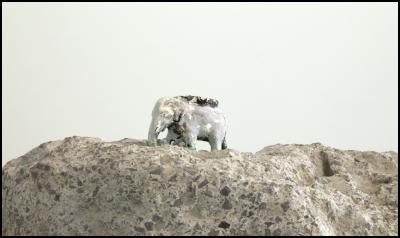Of the Irascible Calm, Opening Wednesday 18 January
g. bridle, Of the Irascible
Calm, Opening Wednesday 18 January at 6pm
Bowerbank Ninow
presents g. bridle - Of the Irascible Calm: 18
January, 2017
Of the Irascible Calm
presents a selection of objects from
g..bridle’s
collection the Retreat, an archive which the artist
has discovered, curated and edited through a process of
independent, private museology. As the name implies, the
Retreat attempts a withdrawal or escape from the
mainstream of art education and artmaking, but it can also
be conceptualised as a place: a safe haven or sanctuary
equally removed from the studio, the gallery and the
academy, in which objects can exist, and be appreciated, on
their own merits. the Retreat seeks such a position
of outsideness or perspective, with varying degrees of
success, but does not necessarily operate at a fixed
distance from these institutional forces. The closeness of
the Retreat to these other aspects of art practice,
or its distance from them, approximates a cavity, a
fracture, a void: but a fertile space, where the prospect of
contact between these estranged surfaces promises the
generation of new meanings and new
possibilities.

Indeed, the Retreat persistently articulates ideas of surface, attachment and contact: the mechanisms by which objects can be connected to one another and to the viewer. In terms of the dynamics of the museum, surfaces are seen as elements which must be protected and insulated: they are varnished, placed behind UV-resistant glass, repaired, mounted, or restored. g..bridle’s engagement with the surfaces of objects in his collection is less didactic. Objects are often combined to form new groupings, or one object will be used as a plinth to display another, in this way acting as a vessel or container for the second object’s meanings and potential narratives. To this end, the artist has cut, chiseled, tied, cast and otherwise modified the objects of the Retreat, sometimes even creating new objects from scratch: an inverted process of conservation, which questions the meanings and values implicit in the activities of the museum and the gallery.
the Retreat is displayed in
the form of exhibitions, and finds its fullest expression in
the relationships created when objects interface with one
another or with the spaces they inhabit. Fitting, shaping
and assembling are important concepts: g..bridle’s
practice positions the artist as a rogue archivist,
negotiating between the demands of the objects under his
charge and the spaces in which they are to be displayed, and
attempting to articulate a logic which governs their
selection and placement. This negotiation is linked to the
use-value of the objects themselves, whether that value is
practical or as part of a semiotic system. This latent
functionality parallels the ways objects have historically
been depicted in art, particularly painting, as having a
metaphorical function which parallels their physical
usefulness. In this sense, it is important that objects in
the Retreat have a reason for being which is divorced
from their aesthetic qualities. Many of the pieces displayed
in Of the Irascible Calm were made with functionality
in mind (a coat-hook, a shooting stick, an ashtray) but have
been modified or repositioned so that their functions and
histories are likewise altered or recontextualised.
Nevertheless, they preserve an aura of usefulness,
components and tools which have the potential to be
redeployed or reactivated.
In the Retreat,
as in more traditional museological projects, objects appear
to be ascribed a value which is linked to their status as
containers for historical meanings. However, their potential
as carriers for narrative is subtly undermined by the
quixotic nature of their display: the actual histories of
these objects, the stories of their making, use, and
survival, are blurred and absorbed into other, imagined
histories, chimeric timelines conjured up in the space
between object and viewer. There is an element of
Romanticism in the Retreat, an inherent tension
between its investigation of the complex dynamics of
artistic production and its desire to return to the
immediacy of engagement with materials for their own sake,
and perhaps even to locate in them some elusive vestige of
the
sublime.
ends


 National Youth Theatre: 140 Christchurch Kids Shine In National Youth Theatre’s Historic CATS Premiere
National Youth Theatre: 140 Christchurch Kids Shine In National Youth Theatre’s Historic CATS Premiere NZ Symphony Orchestra: NZSO To Tour Masterworks By Mozart, Beethoven, Haydn And More
NZ Symphony Orchestra: NZSO To Tour Masterworks By Mozart, Beethoven, Haydn And More Journal Of Public Health: Vape Shops Cluster Around Schools
Journal Of Public Health: Vape Shops Cluster Around Schools Timaru District Council: Aigantighe Art Gallery Hosts An Iconic Robin White Touring Exhibition
Timaru District Council: Aigantighe Art Gallery Hosts An Iconic Robin White Touring Exhibition Victoria University of Wellington: Dame Winnie Laban Awarded Honorary Doctorate Recognising Achievements For Pasifika
Victoria University of Wellington: Dame Winnie Laban Awarded Honorary Doctorate Recognising Achievements For Pasifika  HESSA: This Isn’t Fair—And It’s Time To Fix It - HESSA Petition Calls For Inclusive Student Sports
HESSA: This Isn’t Fair—And It’s Time To Fix It - HESSA Petition Calls For Inclusive Student Sports